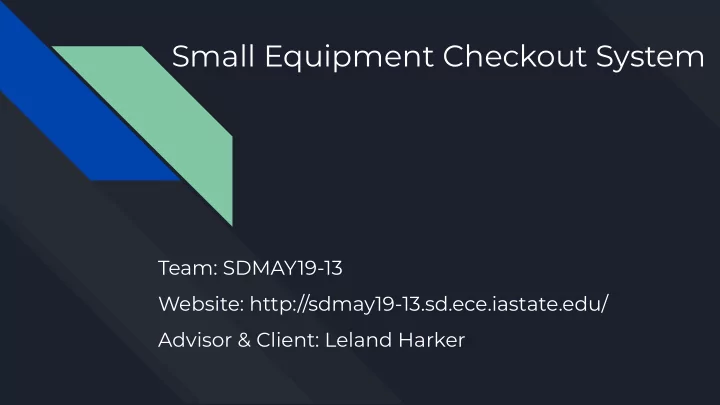

Small Equipment Checkout System Team: SDMAY19-13 Website: http://sdmay19-13.sd.ece.iastate.edu/ Advisor & Client: Leland Harker
Team Members Yimin Wang Jiaxin Li Fengnan Yang Major: Electrical Engineering Major: Electrical Engineering Major :Electrical Engineering Team Role: Project Manager Team Role: Treasurer Team Role: Reporter & Meeting manager Technical Role: Hardware Team Technical Role: Hardware Team Technical Role: Hardware Team Caining Wang Bei Zhao Major: Computer Engineering Major: Computer Engineering Team Role: Software developer Team Role: Secretary Technical Role: Software Team Technical Role: Software Team
System Design
Problem Statement ● Continuing sdmay18-01 Group's work ● ETG’s limited working time ● Low efficiency ● Waste of human resource
Functional Requirements (For students) ● Users can check the availability of each item on the front page. ● After Selecting an item to check out, the LED in the corresponding unit will be turned on for checking purpose. ● The system will ask users to sweep the ID card to open the lock. ● Users can review the currently checked out equipment (personal). ● Users can return equipment and close checkout record. ● Report any damaged item to ETG.
Functional Requirements (For Administrators) ● Log in and out ● Create, read, update and delete available equipment. ● Determine max checkout durations for items. ● Create, read, update and delete student users, records, and user privileges. ● Create update, remove locker units ● Add new Administrators
Non-functional Requirements ● The PCB should be designed smaller enough so it can fit into the plastic cover. ● The hardware should be able to work stably for 24/7. ● All the control PCBs in lockers should be connected through a single bus line, so the number of units can be extended easily. ● Administrators can add more units by connecting more PCBs and updating the database, without modifying the circuit design.
Appearance of the whole project Locker unit for Raspberry Pi and master PCB Locker unit for item and slave PCB
Conceptual Sketch
Design Detail
Hardware
Whole Circuit
Slave Device PCB Design Size : 48mm * 21mm * 5mm
Voltage Regulator Output : 5V 12V GND GND Components ➢ Capacitors : 100uf Diode : 1N5819G ➢ ➢ Inductor : 100uH Voltage Regulator : LM2575S ➢
DS2408 Slave Device Single Channel Addressable Switch ● Pins Function 8-Channel Addressable Switch ➢ Vcc : 5V Power Supply (DataSheet) IO : Data Signal from Master Device ➢ ➢ PIO-0 : 12V Electric latch PIO-1 : 3.2V LED ➢ ➢ PIO-2 : Hall-Effect Sensor
Latch Circuit 12V Electric Lock ● Components Capacitors : 0.1uf ➢ ➢ Nmos : AOD454A Locker : 12V Electric Latch ➢
Door Detecting Circuit & LED - Power supply: 5 V from voltage regulator - Power supply: PIO 1 of DS2408 - Pull-Up resistance: 10K-ohm - Pull-Up resistance: 220 ohm - Output connected to the PIO 2 of DS2408 - Output: 2.6V/0.4V - Output: 5V/0.02V
Cost Resource : https://www.digikey.com/
Software
Website homepage & OWFS address page
Software Implementation
Database schema of Web application
Iowa State University’s Attendance Tracking System - ATRACK An API provided by university to get basic student information through University ID(ISU card) Net-ID ● Name ●
Potential & Actual Risks Potential Risk - Because the system needs to collect student ID information, it is possible that this information will be leaked under cyber attack. - The Raspberry Pi is placed in a box without a cooling system and will work for 24/7. It is possible to become overheated. Actual Risk - Used jumper wire to connect master PCB and slave PCB during the test, which short and burn the master device (12V output and 5 v input in wrong order). - Solution: using 2 mm 3 pin connect header and cable.
Conclusion
Potential Improvements ● Complete the door detecting system. Add more locker units to the whole checkout system. ● ● Design and implement the cooling solution for the unit that stores the Raspberry Pi and master PCB.
Proposed plan for this semester
Current project status
Demo Video
Thanks Q&A
Recommend
More recommend